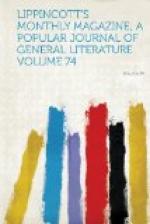[Footnote 3: This lady’s granddaughters, her son’s daughters—the duchess of Somerset, Queen of Beauty in the celebrated Eglinton Tournament; the countess Gifford, mother, by her first husband, of Lord Dufferin, viceroy of Canada; and the Honorable Mrs. Norton, the well-known authoress—were famous in their day for beauty. Gainsborough passed many years at Bath, where his intimacy with the Linley family, then resident there, commenced. The following is from Fulcher’s Life of Gainsborough: “After returning from a concert at Bath, where we had been charmed with Miss Linley’s voice, I went home to supper with my friend (Gainsborough), who sent his servant for a bit of clay, with which he modeled, and then colored, her head—and that too in a quarter of an hour—in such a manner that I protest it appeared to me even superior to his paintings. The next day I took a friend or two to his house to see it, but it was not to be seen: the servant had thrown it down from the mantelpiece and broken it.” Gainsborough would now and then mould the faces of his friends in miniature, finding the material in the wax candles burning before him: the models were as perfect in their resemblance as his portraits.]
[Footnote 4: The history of the Bouverie family settling in England is curious. The family had, prior to 1542, long been settled in Flanders. In that year was born, near Lisle in that country, Laurence des Bouveries, as the name was then written, founder of the English branch. Laurence, from mixing with his father’s Protestant tenants, had imbibed some of their ideas, and his father, a stern Catholic, told him that if he failed to appear at mass the following Sunday he would have him examined by the Inquisition. In terror he ran away to Frankfort-on-the-Main, and there had the luck to fall in with a sympathetic silk manufacturer, who made him superintendent of his men. Subsequently he married his patron’s niece and heiress, and eventually removed to England when Queen Elizabeth offered an asylum there to those of the Reformed faith. His family made wealthy alliances and prospered, and in 1747 his representative was created a peer. He married, first, the heiress of Delapre, and her property went to her second son, Edward. His eldest son by his second marriage took the name of Pusey, and was, father of the celebrated Dr. Pusey.]
[Footnote 5: Lord Cairns, then Sir Hugh, opened the case for the claimant, and received, it was said, two hundred and fifty guineas for the work, which occupied about two hours. Sir Fitzroy Kelly appeared as counsel for the family. He spoke for about fifteen minutes, and his fee was the same.]
HINTS FOR NOVEL-WRITERS.
“Constance,” said Philip to his sister, “I have got on very well with my novel. I have written fifty pages, described my hero and heroine, made them thoroughly in love with each other; and now I intend to part them for a season, without letting them be certain of the state of each other’s heart. I think narrative my forte, but it will not do to have no conversations, and my dialogues seem so short and trite. Do look over this:




